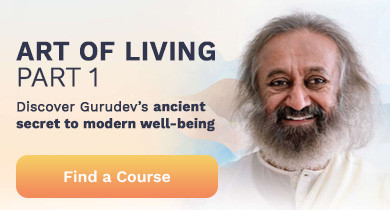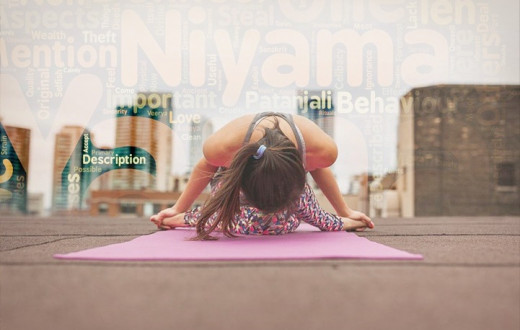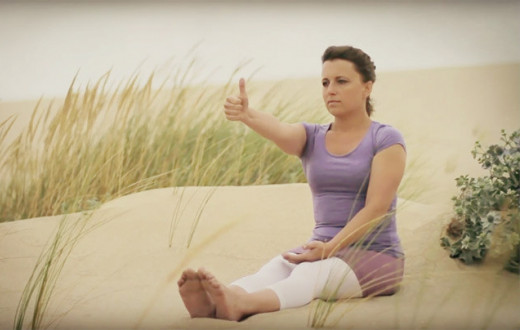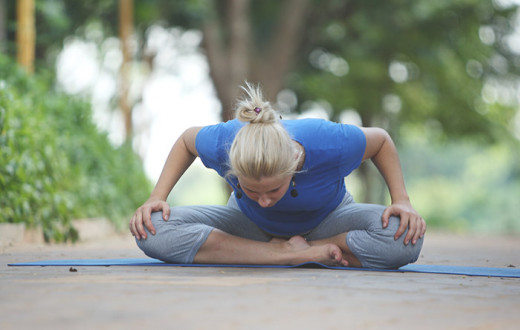By Shriram Sarvotham|Posted: March 01, 2019
The term “asana” from Sanskrit literally means “seat.” By practicing asanas, we gain the ability to seat ourselves comfortably and steadily. Rather than getting caught up in the discomforts of the body, we can direct our lives to their intended purposes. We can focus on other more important things, such as to experience and express the most beautiful parts of ourselves, like peace, joy, friendliness, and creativity. While this is the primary reason described in the classic yoga texts for doing asanas, we can also enjoy a multitude of health benefits that accrue when we practice yoga postures regularly.
Imagine driving through the countryside and enjoying beautiful scenery. If our car is in good condition, it serves us well on our journey. On the other hand, if the vehicle is in bad shape, our focus in not fully on the scenery. Much of our mental energy is consumed by concerns for the vehicle, as the troubles and torments of the vehicle reveal themselves to us. A run-down car serves as an obstacle towards experiencing & enjoying the beauty of the scenery.
In like manner, our body is the vehicle we use in the journey of life. Is the vehicle serving our intentions? When the body is troubled with lack of ease, or disease, we’re stuck at the gross level of our existence; it becomes difficult (but not impossible!) to experience harmony with life, with ourselves. In fact, Maharishi Patanjali, the father of yoga, mentions disease of the body (vyadhi) as the first of the nine obstacles towards the path of yoga.
A healthy and disease free body helps us to live to the fullest, to participate and contribute effectively and positively in all areas. Today, the practice of yoga postures has been embraced worldwide by millions of people in order to establish health and well being in their lives.
But what’s a yoga posture? Is it just a nifty way to move the body into complicated positions?
Asana and its place in yoga
Maharishi Patanjali, in his treatise Yoga Darsana, lists eight limbs — or eight parts — to the practice of yoga. Yoga recognizes that the body is just one aspect of our existence. In order to experience true well-being, it’s important to bring harmony to all aspects of our self – including the body, mind, breath, and even our relationship to the outside world – people and things. The eight limbs of yoga provide a blueprint on how to do that, by bringing harmony to each of the layers of our existence. In this sense, the practice of yoga is holistic – it attends to our system as a whole. Asanas comprise the third limb of the eight limbs of yoga described by Patanjali.
Yoga Darsana consists of short, terse sutras or aphorisms that capture the essence of yoga. Of the 196 sutras (or 197, as some sources claim an extra sutra) penned by Patanjali in Yoga Darsana, only three of them are related directly to the practice of asanas.
Only three sutras!! The physical postures occupy only a miniscule fraction of yoga! Surprisingly, the popular perception of yoga today is almost entirely about body postures!
Yet asanas can serve as a great entry point into yoga. Most people who practice yoga – myself included – began yoga thanks to postures. Some are inspired towards postures when they see their flexible yogi friends or pictures in yoga magazines. Some others are drawn to yoga because of the health benefits.
Before long, many find that the postures comprise a tiny part of yoga; they discover a whole new dimension relating to subtler practices for the “inner world,” like recognizing the power of the breath and experience of deep meditation.
Asana is just the appetizer!!
Let’s look at the three sutras Patanjali has given on asanas. These key sutras lay the foundation for the practice of yoga postures. An understanding of the principles described here will powerfully enhance the quality of yoga asana practice!
What is asana? And how to do it?
In the first of the three sutras, Patanjali defines asana as more than a simple yoga posture. Asana happens when there is steadiness (sthiram) and comfort (sukham). When the pose is stable and brings joy, it’s asana.
What a simple and elegant definition!!
Note that straining and torturing the body into a posture isn’t asana. New students of yoga are (pleasantly) surprised by this revelation!
Even if the posture looks perfect from outside, while the inner experience isn’t one of joy or comfort, it isn’t an asana. Furthermore, if the posture is unsteady – for example, if the body is shaking while holding the pose, it isn’t an asana.
On the other hand, regardless of the appearance, if the pose is stable and the body is experiencing comfort, it qualifies. When we practice this way, the body naturally develops health, lightness, strength, and flexibility in due course of time.
While doing poses, check with these two metrics. Is the body steady while I am holding the pose? Am I feeling good? If the answer is no to either of the questions, then perform some adjustments to the pose. Listen to your body; use the body sensations as guidance to find your perfect place in the asana. One of the aspects of yoga is body awareness, and how sensitive we are to the messages of the body.
Releasing your struggle
The second sutra talks about how we can deepen the experience of the asana. Patanjali suggests releasing the struggle that we offer while holding the pose. When we do that, we experience boundless bliss.
As beginners, when we enter into a yoga pose, we exert much more effort than necessary in order to hold the pose. When we consciously release the struggle, the pose becomes effortless with practice. We’re able to get into the pose, hold it for the intended duration, and come out of it with graceful ease. Rather than dragging the body into the pose, we allow the body to flow in and out of the pose gracefully
As an analogy, consider a student of music learning to play an instrument. In the beginning, there’s so much effort and struggle as they learn to produce melody. With practice, the struggle subsides. When mastery is attained, the playing is effortless. The awareness is now on the bliss of the music, not on the technique of the instrument. Likewise, when we release the struggle from the yoga pose, we experience unbounded blissful awareness and lightness of the body!
How do we know if we’re using excess effort in a pose? Or struggle? The key is to listen to the breath. In fact, the Sanskrit word Patanjali uses for struggle – prayatna – is also translated in the context of yoga as the breath. If we’re struggling, the flow of breath is uneven. Seek to make the breath long and deep, soft and even.
So listen to the body to check your stability and comfort. Listen to the breath to check your ease and effortlessness.
Benefits of practicing asanas
Patanjali’s third sutra on asanas states the benefits. He captures the essential benefit of doing asanas, namely – removing “dvanda.” Let’s look at what this Sanskrit word means.
“Dvandva” literally means “duality” or “division” (perhaps these three words are related historically). It refers to a state that’s in conflict, or broken. When we’re confused, or when the mind is scattered in too many directions in a given moment, we experience dvandva. Gurudev Sri Sri Ravi Shankar says that whenever one is confused, it’s best to do asanas. Right away, clarity comes because the dvandva drops. Try it!
Dvandva can also express itself at the level of the body in many ways – like lack of coordination in the body. A classic example of such lack of coordination is that between the tongue and the body’s innate intelligence. That’s why for many, the tongue craves for junk food, while the body truly seeks nutritious food. The tongue and the body intelligence aren’t working together as one; they’re divided. (I’m sure many can relate to that!)
Our attachment to junk food reduces when we integrate the practice of asanas in daily life. As a yoga teacher, I’ve seen innumerable students come back and share how their food choices have changed after doing yoga. Their attachment to junk food slowly withers away, and they’re naturally drawn towards nutritious food. In other words, the sense of taste starts working in harmony with the body’s intelligence.
Dvandva is an expression of “rajas,” or restlessness in the mind and body. Rajas is one of the 3 gunas or tendencies. Rajas is characterized by a disorganized flow of energy. The manifestation of rajas is indicated by intense flow of energy, but one that’s not life-supporting. For example, rage, craving, obsession, and anxiety would qualify as expressions of rajas in the mind. Restlessness and fidgeting are expressions of rajas in the body.
There’s a verse in Yoga Choodamani Upanishad that says “asanena rajo hanti,” meaning the practice of asanas eliminates rajas in the system. (I am grateful to Yogacharya Srivatsa Ramaswami for pointing me to this verse.) Many more benefits of asanas are described in the classic Hatha Yoga texts. Hatha Yoga Pradipika says asanas promote strength, health and lightness in the body. It describes several yoga postures and lists benefits for each of them.
The rewards of doing asanas extend beyond the body. If you’ve done them, you know the feeling – well-being is felt at much deeper levels. The breathing is more relaxed and smooth; the mind is freed from restlessness and the quality of awareness is enhanced. This lays the perfect platform for deeper practices, including pranayama (control / harmony of the prana using breath-work), dhyana (meditation) and other practices
But the benefits of pranayama and dhyana are very different from those of asanas. Pranayama reduces & eliminates tamas (dullness, lack of clarity) and dhyana promotes satva (pure awareness, life-supporting, life-enriching experience of well-being). Together, the combination of postures, breathwork, and meditation work in synergy; they complement each other to provide holistic care for health and well-being. Detailed exposition on pranayama and dhyana will be considered in separate blog posts.
If you’re doing yoga postures everyday, try incorporating the principles described by Patanjali, and notice a change in quality of the practice. If you haven’t done yoga before, perhaps you can consider introducing it in your life; asanas are a great way to start! A healthy body is just the beginning of the multitude of benefits you can experience.
This article was originally published on Sriram’s Blog.
Shriram Sarvotham, yoga teacher since 1991, holds a PhD degree in Electrical Engineering from Rice University, Houston, TX. He works in the tech industry in Silicon Valley California.





























